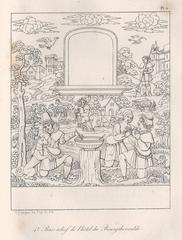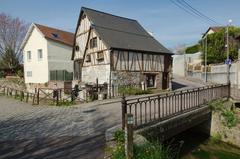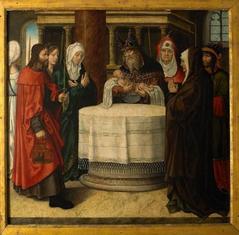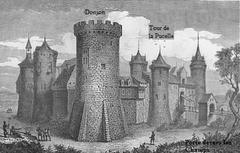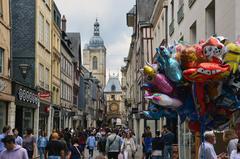
Musée Le Secq des Tournelles Visiting Hours, Tickets, and Essential Visitor Guide to Rouen Historical Sites
Date: 04/07/2025
Introduction
Located in the heart of Rouen’s historic center, the Musée Le Secq des Tournelles is a remarkable institution celebrating the artistry, history, and cultural significance of ironwork. Housed within the atmospheric Gothic Church of Saint-Laurent, the museum boasts the world’s largest public collection of historic ironwork—ranging from grand architectural gates to delicate locks, keys, and jewelry—spanning from the Gallo-Roman era to the early 20th century. Whether you’re an art lover, history enthusiast, or a curious traveler exploring Rouen’s cultural tapestry, this guide provides everything you need: visiting hours, ticketing details, accessibility, highlights, and practical tips to ensure a rewarding visit. For the latest updates and virtual resources, consult the Musée Le Secq des Tournelles official website, Normandie Lovers, and Rouen.fr.
Table of Contents
- Introduction
- History and Significance
- The Le Secq des Tournelles Family and Collection Origins
- A Historic Setting: The Church of Saint-Laurent
- Museum Highlights and Noteworthy Pieces
- Visiting Hours and Tickets
- Directions, Accessibility, and Visitor Services
- Nearby Attractions in Rouen
- Events, Tours, and Workshops
- Visual and Interactive Resources
- Visitor Tips
- Frequently Asked Questions (FAQ)
- Conclusion and Next Steps
- References and Further Reading
History and Significance
The Musée Le Secq des Tournelles is a unique cultural institution founded on the vision of Jean-Louis-Henri Le Secq Destournelles (1818–1882), a pioneer in French photography, and his son Henri Le Secq des Tournelles (1854–1925). Their mission was to preserve the heritage of wrought ironwork at a time when industrialization threatened to erase traditional craftsmanship (clarkart.edu; museelesecqdestournelles.fr). The museum’s collection, the largest of its kind globally, comprises over 15,000 artifacts—monumental gates, stair railings, locks, keys, shop signs, scientific instruments, and jewelry—offering a comprehensive panorama of iron’s evolution in art and daily life.
The collection found its permanent home in the restored 15th-century Church of Saint-Laurent, a building rich in its own history. The church’s Gothic architecture, with its dramatic nave and stained-glass windows, provides an evocative setting that enhances the appreciation of ironwork’s artistry and technical ingenuity.
The Le Secq des Tournelles Family and Collection Origins
The museum owes its existence to the dedication of two generations of the Le Secq des Tournelles family. Jean-Louis-Henri Le Secq Destournelles, originally a painter and one of France’s earliest photographers, became fascinated by decorative ironwork while documenting historic monuments (clarkart.edu). He began systematically collecting iron objects around 1865, recognizing their threatened status. His son Henri inherited this passion, significantly expanding the collection and ensuring its preservation by offering it to the city of Rouen in 1917, with the stipulation of curating and installing it in a suitable setting (musees-normandie.fr).
A Historic Setting: The Church of Saint-Laurent
Situated at 2 Rue Jacques Villon, the Church of Saint-Laurent provides a fitting backdrop for the museum’s treasures (rouen.fr). The church’s history dates back to the 11th century, with multiple reconstructions following fires, revolutions, and structural collapses. Deconsecrated during the French Revolution, it was saved from ruin in the late 19th century and restored by 1911, coinciding with Normandy’s millennium (musees-normandie.fr). The museum officially opened its doors in 1921.
Museum Highlights and Noteworthy Pieces
The collection encompasses between 14,000 and 16,000 objects, representing centuries of ironworking mastery from Europe and beyond (normandielovers.fr; whichmuseum.com). Notable highlights include:
- Locks and Keys: Intricate medieval and Renaissance locks and keys, showcasing both technical skill and artistic flair.
- Architectural Ironwork: Monumental gates, balconies, grilles, and stair railings from Gothic and Belle Époque periods.
- Shop Signs and Emblems: Ornate wrought iron signs, some shaped like animals or tools, revealing the visual language of historic commerce.
- Household Items: Irons, coffee grinders, candlesticks, mirrors, and jewelry boxes, illustrating the blend of utility and artistry.
- Scientific Instruments and Tools: Specialized pieces attesting to iron’s role in technological progress.
The permanent collection is complemented by rotating special exhibitions. For example, the recent “Le Temps des Collections” featured Paco Rabanne’s innovative metalwork fashion (museelesecqdestournelles.fr).
Visiting Hours and Tickets
- Opening Hours: Open daily except Tuesdays, from 14:00 to 18:00 (2:00 PM–6:00 PM). Closed January 1, May 1 and 8, Ascension Day, July 14, August 15, November 1 and 11, and December 25 (musees-normandie.fr).
- Admission: Free entry to the permanent collections (rouen.fr). Special exhibitions may require a ticket—verify on the official website.
- Guided Tours: Available by appointment for groups and individuals; workshops are regularly organized for families and children (museelesecqdestournelles.fr).
Directions, Accessibility, and Visitor Services
- Location: 2 Rue Jacques Villon, 76000 Rouen, France. The museum is a short walk from Rouen’s main train station and close to other city center attractions (visiterouen.com).
- By Public Transport: Numerous bus and tram lines stop nearby.
- By Car: Paid parking is available, but public transit or walking is recommended due to limited spaces.
- Accessibility: The Rue Deshays entrance is wheelchair accessible; staff can assist with navigation inside, although historic flooring may present minor challenges.
- Restrooms: Available on-site.
- Cloakroom: Not available—pack lightly.
- Photography: Non-flash photography is permitted in permanent collections; check for restrictions during special exhibitions.
- Languages: French signage predominates, with some English translations; translation apps are helpful for non-French speakers.
Nearby Attractions in Rouen
Enhance your cultural itinerary by visiting these Rouen landmarks:
- Musée des Beaux-Arts de Rouen: A leading art museum with masterpieces from the Renaissance to the 20th century.
- Rouen Cathedral: Famed for its Gothic architecture and Monet’s series of paintings.
- Gros Horloge: The iconic astronomical clock nearby.
- Historic Old Town: Picturesque cobblestone streets, half-timbered houses, shops, and cafés.
Events, Tours, and Workshops
- Guided Tours: Book in advance for in-depth explorations of the ironwork collection.
- Workshops: Regularly scheduled for families and school groups, focusing on ironworking techniques and artistic creativity.
- Special Exhibitions: The museum hosts rotating exhibitions on themes such as fashion, technology, or contemporary ironwork. Check the museum events page for current listings.
Visual and Interactive Resources
- Virtual Tour: Explore highlights online before your visit (virtual tour).
- Map: Use online maps for navigation (map example).
- Photo Galleries: Preview the collection and plan your visit.
Image Suggestions:
- Exterior photo of the Gothic church with alt text: “Musée Le Secq des Tournelles Gothic church facade in Rouen”
- Close-up of intricate wrought ironwork with alt text: “Intricate wrought ironwork displayed at Musée Le Secq des Tournelles”
- Interior exhibition view with alt text: “Interior view of Musée Le Secq des Tournelles showcasing historic iron artifacts”
Visitor Tips
- Plan at least 1–2 hours for your visit to fully appreciate the collection.
- Visit in the afternoon for the best lighting inside the church.
- Check the website for current exhibitions and guided tour availability.
- Contact ahead for accessibility accommodations.
- No café on site—enjoy nearby city center dining options.
- No gift shop—seek Rouen souvenirs in local shops.
Frequently Asked Questions (FAQ)
Q: What are the Musée Le Secq des Tournelles opening hours?
A: Open daily except Tuesday, 2:00 PM–6:00 PM; closed on major public holidays.
Q: Is admission free?
A: Yes, entry to permanent collections is free. Some temporary exhibitions may charge a fee.
Q: Are guided tours available?
A: Yes, by appointment; workshops are also offered.
Q: Is the museum accessible to people with disabilities?
A: Yes, through the Rue Deshays entrance; some surfaces inside may be uneven.
Q: Can I take photos inside?
A: Non-flash photography is allowed unless otherwise indicated.
Q: How do I get to the museum?
A: Centrally located at 2 Rue Jacques Villon; walkable from major attractions and public transport.
Conclusion and Next Steps
The Musée Le Secq des Tournelles is a must-see for anyone interested in decorative arts, history, or the unique legacy of ironwork in France. Its unparalleled collection, dramatic architecture, and welcoming policies (including free entry) make it a highlight among Rouen’s historical sites. For the latest updates, special events, and virtual resources, visit the official museum website. Enhance your experience with the Audiala app for curated audio guides and insider tips, and explore related articles on Rouen’s cultural attractions for a comprehensive Normandy itinerary.
Summary of Key Points
- The Musée Le Secq des Tournelles features the world’s largest collection of historic ironwork, set in a restored Gothic church in Rouen.
- Free entry to permanent collections; special exhibitions may require tickets.
- Guided tours, workshops, and educational activities available by appointment.
- Central location with easy access to other Rouen historical sites.
- Check the museum’s website for up-to-date information on hours, events, and accessibility.
Whether you’re passionate about art, architecture, or craftsmanship, the Musée Le Secq des Tournelles offers a fascinating and memorable experience in the heart of Normandy.
References and Further Reading
- Musée Le Secq des Tournelles official website
- Normandie Lovers
- Rouen.fr
- Visiterouen.com
- Clark Art Institute
- Musée Normandie

